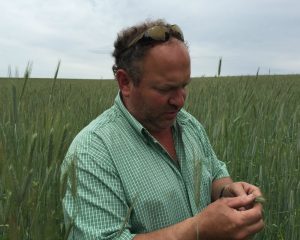Joe BraggerIndependence, WI
 Joe Bragger
Joe Bragger
Buffalo County, Wisconsin
Buffalo County LCD
Dairy and row crop producer Joe Bragger owns and operates a 300-cow dairy farm and two satellite farms where he maintains 1,380 acres of cropland (500 in corn, 300 in soybeans, 300 in hay), woodland, and pasture, along with 2 miles of streams. Bragger also rears 4,000 trout annually and raises pullet chickens with his wife, Noel. Joe runs the family farm with his brother Daniel and sister-in-law Mary, who raise broilers for Gold’n Plump. Joe’s mother, Hildegaard, also lives on the farm.
The Bragger family has been using agricultural conservation practices in rural Independence, Wisconsin, since the 1960s to preserve soil and water resources. Joe is involved in many aspects of conservation and believes engaging farmers is the key. In his “spare” time, he participates in rule making processes for technical programs and standards development, and believes that teaching and learning are important tools.
Bragger uses no-till (and has been for 15 years), residue management, cover crops, crop rotation, contour strips, buffers, and nutrient management, and has completed the installation of wildlife habitat plots, pollinator habitat, streambank restoration, and bluff prairie restoration. Bragger has modified his planter to reduce soil disturbance and has removed coulters or fertilizer openers on his other machinery.
Driving around Wisconsin in March or April, you’d expect to see runoff from bare farm fields. At the Bragger farm, however, everything is green. Incorporating cover crops into the row crops has stabilized steep slopes while improving soil health. With less soil runoff there is less nutrient loss from the fields. Joe uses a fertilizer buggy to seed winter rye as a cover crop into corn silage.
“If we don’t take care of this land, it won’t be able to sustain production and have greater production and yields,” Joe says.
Bragger is a big proponent of cover crops, but incorporating them at the right time can be challenging with Wisconsin’s shorter growing season. Currently, his goal is to establish 10,000 acres of cover crops within his community’s watershed. He plans to accomplish it by starting a producer-led group and Research and practical experimentation on the farm will help the group better understand how to get cover crops established throughout the year with various crops, including grain crop, soybean, corn, alfalfa, and rye.
Challenges
Buffalo County is situated in the Driftless area of the Midwest which presents an extremely challenging topography for farming. The Bragger farm is located at the bottom of a narrow valley with steep bluff slopes extending on either side with any available flat ground typically located close to small, meandering streams – making row cropping difficult, or tops of bluffs with less than desirable soils.
Even though the farm is situated in a very challenging location, Bragger says, “the longer we’re here the more we become attached to it. It is not dirt. It is a living, breathing organism that we can nurture and make better.” Bragger believes no-till farming practices have the best results in the driftless area landscape with steeper slopes. “Soil conservation is very important for long-term profitability of any operation. Trying to keep the soil in place ultimately led us to using no-till. The more we can get away from disturbing the soil, the less erosion we are going to have. The residue is shielding our soil surface to prevent it from drying out. There’s more life within the soil. We use less fuel, less labor, and less equipment, so no-till is ultimately a win-win. In areas that are more sensitive, we put in a cover crop to help hold the soil in place, shield it from raindrop impacts, and add organic matter.”
Another challenge is adapting to changing land use practices, which have changed the hydrology of the area and increased sediment inputs into the Bragger farm. There are very few dairy farm operations remaining. With less cows on the landscape there is less grass and more woodlands and row crops. With the decrease in grass and cows there has been an increase in sedimentation and flashy flood events funneled downstream. Soil and water conservation structures including grade stabilization dams, grassed waterways, and diversions have been installed in coordination with local NRCS and County Conservation staff since the early 1970s on the Bragger farm to slow the water down and capture and filter sediment.
Several grade stabilization dams were put to their limit during a recent heavy rain event. If these structures had not been in place and had not been maintained by Joe, the flood event would have devastated the farm. Streambank buffers and field edge buffers are maintained using prescribed burning and by incorporating poultry cleanings using a side spreader for vigorous grass growth.

